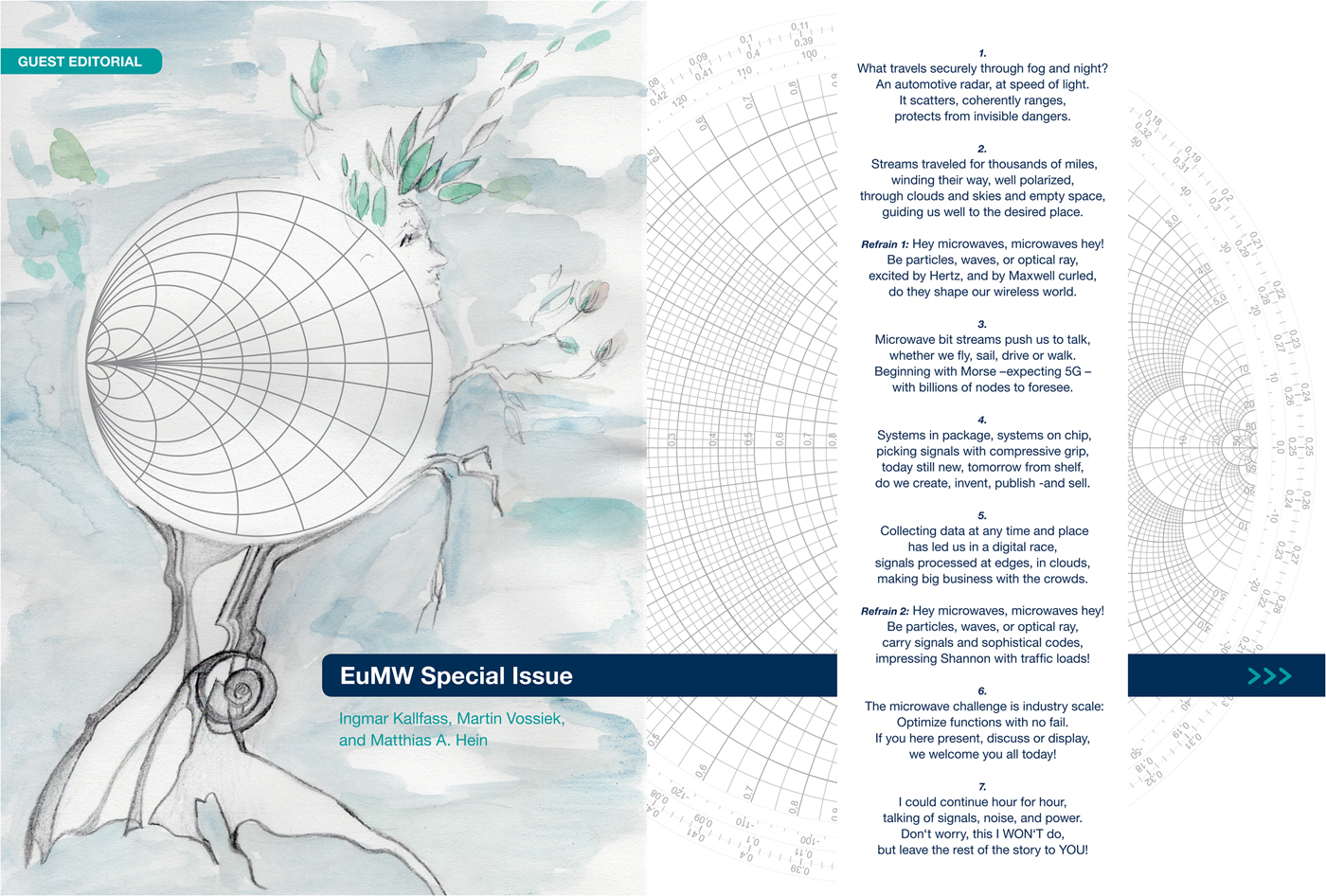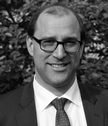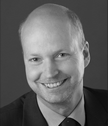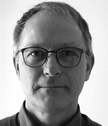
The 20th European Microwave Week was held in Nuremberg, Germany, from October 8 to 13, 2017. In conjunction with a record-size industrial exhibition and 43 workshops and tutorials, it hosted three conferences: the 47th European Microwave Conference (EuMC), the 12th European Microwave Integrated Circuits Conference (EuMIC), and the 14th European Radar Conference (EuRAD). Within a week, the latest international achievements in the research and development of RF, microwave, millimeter-wave, and terahertz devices, systems, and technologies were presented, making this the premier European microwave event. Approximately 1600 individual delegates attended the week, excluding visitors to the exhibition.
This special issue of the International Journal of Microwave and Wireless Technology is devoted to the European Microwave Week EuMW2017. It contains extended versions of conference papers that succeeded in attaining the highest scores from the thorough review process, as acknowledged by the Technical Program Committee. The Journal submissions then went through an additional review and editorial process. Only the top 10% rated conference contributions were invited to submit an extended version to the journal, a truly selective procedure indeed. The content of this issue reflects the breadth and quality of the three conferences, and doubtlessly offer something of value to every interested reader.
The contributions represent the wide range of high-frequency-related topics, from materials and technologies to integrated circuits and systems, covering all their aspects: Theory, simulation, design, measurement, and real-world system applications. We observe that frequencies of interest cover the electromagnetic spectrum from microwaves through millimeter-waves up to the Terahertz range, even with excursions into the optical range. Beside passive circuits, the majority of papers concern active systems, with several contributions on digital array and signal processing. Papers deal with a wide range of technologies: From inkjet-printed lines, right/left-handed transmission lines, and magneto-dielectric substrates, through MEMS resonators and MMIC technologies based on latest semiconductor developments, up to optical-resonator and -fiber applications. The applications addressed are equally diverse: From radar-like systems for the accurate detection of lap joints, concealed weapons or moving people to front-end chips, microwave microscopy, and biological sensors. We believe that all these subjects are top of mind for the global microwave community. Research results like these make composing this special issue, just like organizing the week itself, worth all the effort!
Let the above poem, which was composed by one of us (MAH) for the Week's opening ceremony, be your guide to this exciting field of engineering sciences. The poem is dedicated to microwaves – and to you.
As Associate Editors, we would like to thank the authors and their teams for their contributions, and the reviewers for their unsurpassed efforts and patience during the iterative process of reviewing. This process is key to high-quality publications and serves as a reference for young engineering scientists. We also gratefully acknowledge the editors-in-chief for their help and the opportunity to compose this special issue.
We do hope that you will enjoy reading the papers, and that you too will consider publishing your work in the International Journal of Microwave and Wireless Technologies.
 Ingmar Kallfass received the Dipl.-Ing. degree in Electrical Engineering from University of Stuttgart in 2000, and the Dr.-Ing. degree from University of Ulm in 2005. In 2001, he worked as a visiting researcher at the National University of Ireland, Dublin. In 2002, he joined the department of Electron Devices and Circuits of University of Ulm as a teaching and research assistant. In 2005, he joined the Fraunhofer Institute for Applied Solid-State Physics with a focus on nonlinear millimeter-wave integrated circuit design. From 2009 to 2012, he was a professor at the Karlsruhe Institute of Technology in the field of high-speed integrated circuits in a shared professorship with the Fraunhofer IAF in the frame of the German Excellence Initiative. Since 2013, he holds the chair for Robust Power Semiconductor Systems at the University of Stuttgart as part of the Robert Bosch Center for Power Electronics, where his major fields of research are compound semiconductor based circuits and systems for microwave and power electronics.
Ingmar Kallfass received the Dipl.-Ing. degree in Electrical Engineering from University of Stuttgart in 2000, and the Dr.-Ing. degree from University of Ulm in 2005. In 2001, he worked as a visiting researcher at the National University of Ireland, Dublin. In 2002, he joined the department of Electron Devices and Circuits of University of Ulm as a teaching and research assistant. In 2005, he joined the Fraunhofer Institute for Applied Solid-State Physics with a focus on nonlinear millimeter-wave integrated circuit design. From 2009 to 2012, he was a professor at the Karlsruhe Institute of Technology in the field of high-speed integrated circuits in a shared professorship with the Fraunhofer IAF in the frame of the German Excellence Initiative. Since 2013, he holds the chair for Robust Power Semiconductor Systems at the University of Stuttgart as part of the Robert Bosch Center for Power Electronics, where his major fields of research are compound semiconductor based circuits and systems for microwave and power electronics.
 Martin Vossiek received the Ph.D. degree from Ruhr University Bochum, Bochum, Germany, in 1996. In 1996, he joined Siemens Corporate Technology, Munich, Germany, where he was heading the Microwave Systems Group from 2000 to 2003. Since 2003, he has been a full professor with Clausthal University, Clausthal-Zellerfeld, Germany. Since 2011, he has been the chair of the Institute of Microwaves and Photonics (LHFT), Friedrich-Alexander University Erlangen-Nürnberg (FAU), Germany. Martin Vossiek has published more than 200 papers. His research has led to around 90 granted patents. His current research interests include radar, transponder, RF identification, communication, and locating systems.
Martin Vossiek received the Ph.D. degree from Ruhr University Bochum, Bochum, Germany, in 1996. In 1996, he joined Siemens Corporate Technology, Munich, Germany, where he was heading the Microwave Systems Group from 2000 to 2003. Since 2003, he has been a full professor with Clausthal University, Clausthal-Zellerfeld, Germany. Since 2011, he has been the chair of the Institute of Microwaves and Photonics (LHFT), Friedrich-Alexander University Erlangen-Nürnberg (FAU), Germany. Martin Vossiek has published more than 200 papers. His research has led to around 90 granted patents. His current research interests include radar, transponder, RF identification, communication, and locating systems.
 Matthias A. Hein (IEEE M’06-SM’06) received his diploma and doctoral degrees with honors from the University of Wuppertal, Germany, in 1987 and 1992, where he worked on superconductor microwave applications for mobile and satellite communications. In 1999, he received a British Senior Research Fellowship of the Engineering and Physical Sciences Research Council (EPSRC) at the University of Birmingham, U.K. From 1998 until 2001, he headed an interdisciplinary research group of passive microwave electronic devices. In 2002, he joined the Technische Universität Ilmenau as the Head of the RF and Microwave Research Laboratory; he successfully negotiated the continuation and extension of this position in 2010. In his professional career until today, he has authored and coauthored around 520 publications and provided over 30 invited talks or tutorials at international conferences. He has supervised nearly 40 doctoral projects, 80 Master and 20 Bachelor projects.
Matthias A. Hein (IEEE M’06-SM’06) received his diploma and doctoral degrees with honors from the University of Wuppertal, Germany, in 1987 and 1992, where he worked on superconductor microwave applications for mobile and satellite communications. In 1999, he received a British Senior Research Fellowship of the Engineering and Physical Sciences Research Council (EPSRC) at the University of Birmingham, U.K. From 1998 until 2001, he headed an interdisciplinary research group of passive microwave electronic devices. In 2002, he joined the Technische Universität Ilmenau as the Head of the RF and Microwave Research Laboratory; he successfully negotiated the continuation and extension of this position in 2010. In his professional career until today, he has authored and coauthored around 520 publications and provided over 30 invited talks or tutorials at international conferences. He has supervised nearly 40 doctoral projects, 80 Master and 20 Bachelor projects.
Matthias Hein chaired the German Microwave Conference 2012, the European Microwave Conference 2017, and the Technical Program Committee of the IEEE ICMIM 2018. He served as co-organizer and convener of various other international conferences. He is elected board member of the IEEE Joint German Chapter MTT/AP and of the EurAAP. Since 2003, Matthias Hein is a member of the Expert Panel “Radio Systems” of the Information Technology Society (ITG) in the German Association for Electrical, Electronic + Information Technologies (VDE), which he directed from 2009 until 2017. He acts as a referee for high-ranking scientific journals and funding agencies. In 2014, he became spokesman of the Thuringian Center of Innovation in Mobility, where one focus is on intelligent automotive wireless sensor and communication systems and virtual test drives.
His research interests focus on antenna and microwave engineering. The research performed under his supervision has been attracting significant public and private funding since more than 15 years.




